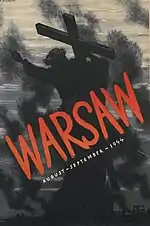Marek Żuławski
Marek Żuławski (13 April 1908 in Rome – 30 March 1985 in London), was a Polish painter, graphic artist and art historian who settled in London in 1937.

Marek Żuławski | |
|---|---|
| Born | 13 April 1908 |
| Died | 30 March 1985 (aged 76) |
| Nationality | Polish, British |
| Education | Warsaw Academy of Art |
| Known for | Painting, graphic art, art history |
Notable work | still life, landscape, figurative art |
Background
He was the son of Jerzy Żuławski, a noted intellectual from a prolific extended family of artists, directors and climbers and of Kazimiera Żuławska, née Hanicka.[1][2] He was raised in Zakopane with his two younger brothers, Juliusz and Wawrzyniec. Later, the family moved to Toruń where he completed his secondary education.[3]
Between 1926 and 1933 he studied at the Academy of Fine Arts in Warsaw under professors Felicjan Kowarski and Karol Tichy at the same time as his cousin, Jacek Żuławski. In 1935 he won a scholarship to study in Paris. In 1937 he moved permanently to London. There he frequented other Polish artists, including Feliks Topolski, Halima Nałęcz, Marian Szyszko-Bohusz and the Themersons.[3] In 1938 he married Eugenia (Imogena) Różańska (1906-1982), but the marriage was short-lived.[4]
Initially he was influenced by Post-Impressionism. After the war he honed his own style, tending towards a simpler form and a more muted palette. His subjects included still life and figurative art such as Chrystus z Belsen 1947, Tancerz 1957, Kain i Abel 1967, Żona Lota 1975 and Akt stojący II 1979, a work on paper. Apart from easel work, he completed several murals as in Our Lady's church in St John's Wood in London, illustrations and graphic art. He created posters (Gordon Bennet, 1935), still life and landscape paintings.[3] Żuławski exhibited on numerous occasions at the London Group.[5]
Written work
He also wrote art criticism and essays, notably, Od Hogartha do Bacona (1973), ("From Hogarth to Bacon"), and Romantyzm, klasycyzm i z powrotem (1976) ("Romanticism, classicism and back again"). He produced a number of talks about art for the BBC Polish Section. He wrote a two-part autobiography, Studium do autoportretu (1980), which was republished in a second edition by the publishing house Oficyna Wydawnicza Kucharski in Poland. His archives are in the Archiwum Emigracji University of Torun Library, and a collection of his art - drawings, graphic art and painting is in the Torun University Museum.[3] His second wife, Halina Korn (1902-1978), was also a writer and painter.[6] In 1980 Żuławski married thirdly, Maria Lewandowska. Their son, Adam, was born in January 1983. In March 1985 Marek Żuławski died in London.[7]
Notable artworks
- Gordon Bennet, 1935
- Quarry Worker, 1949
- Chrystus wśród ubogich, 1953
- Ludzie nad morzem, 1957
- Tancerz, 1957
- Zielony akt na pomarańczowym i czarnym tle, 1958
- Ecce homo II, 1958
- Ecce homo IV, 1961
- Trzy przedmioty na czerwonym tle, 1963/1968
- Kain i Abel, 1967
- Sen o lataniu, 1968
- Martwy człowiek, 1969
- The Team, 1971
- Caribbean Cruise, 1974
- Mechanical Man, 1975
- Żona Lota, 1975
- Marylka w sierpniu, 1979
- Akt stojący II, 1979
- Standing Nude, 1980
- Ojcostwo, 1980
- Wyżyna Golan, c. 1982
- Robotnik, unknown year
Family tree
References
- "Marek Żuławski" (in Polish). sejm-wielki.pl. Retrieved 31 October 2015.
- Kowalczyk, Janusz (2015). "Ród Żuławskich" (in Polish). culture.pl. Retrieved 29 November 2019.
- Małgorzata Kitowska-Łysiak 2008, trans. Paulina Schlosser (2015). "Marek Żuławski". Culture.pl. Retrieved 30 November 2019.
- chronology of Żuławski's life, published by Uniwersytet im. Mikołaja Kopernika (University of Nicholas Copernicus) in Toruń (in Polish)
- chronology of Żuławski's life, published by Uniwersytet im. Mikołaja Kopernika (University of Nicholas Copernicus) in Toruń (in Polish)
- Marek Żuławski, Romance at the outbreak of World War II: meeting Halina Korn
- http://www.marek-zulawski.umk.pl/kalendarz.html#tutaj UMK chronology of Żuławski's life
Bibliography
- "Żuławski Marek". Internetowa encyklopedia PWN. Retrieved 2 March 2007.
- "Żuławski Marek". WIEM Encyklopedia. Retrieved 2 March 2007.